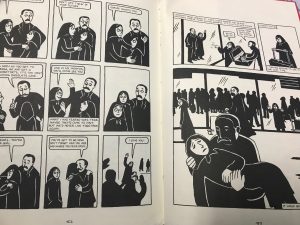Published in 2003 (English translation), the graphic memoir Persepolis: The Story of A Childhood, follows the childhood and young adulthood of Marji after the Iranian revolution in 1979. Illustrated and written by Marjane Satrapi, Persepolis tells the story from Marji’s perspective during moments of intense political conflict in Iran. The importance of Persepolis is that it does not refrain from depicting images of a brutal violence and torture, which has resulted in the graphic memoir being banned in several countries (Case Study). An intriguing element about Persepolis, is that the graphic narrative is illustrated in black and white, which is a contrast to the bright red cover. The lack of colour involved in the graphic memoir functions to convey subliminal messages, Marji’s innocence and reminds us who the story belongs to.
One of the most striking features about Persepolis, is that it is illustrated in black and white; which is unique and therefore separates itself into a different category. In our ASTU class, we discovered that this black and white style is similar to Maus by Art Spiegelman, another graphic novel with heavy underlying political influence. In an interview, Satrapi states that “words are never enough” and how she prefers graphic narratives which provides a “literary and cultural map” (Words Are Never Enough).
The use of illustrations in graphic memoirs like Persepolis, provides another dimension to the story. The reader is given a visual component which allow messages to be conveyed without words. For example, on page 70, where we can see that the shape of the speech bubbles changes as Marji become increasingly frustrated. The speech bubbles shapes are rectangular in the second tier and to become sharp and pointy edges, representing her passion and tone. Following the same pattern of the speech bubbles, the reader can notice the changes in punctuations. From ellipsis, which represents hesitation to a contrasting and definitiveexclamation point. We can see in the technical details of this page; how graphic novels reveal Marji’s emotions without directly stating them. Instead, we can see them intensify through the use of punctuation, Marji’s body language and speech bubble shape.
 Another example is from pages 152-153, where we can see how all Marji and her parents are all dressed in black, which represents that there is a sense of somber amongst them and foreshadows to their separation. We can see throughout the graphic memoir, Satrapi uses black to represent sadness, suppression and violence. In many of the panels for war, riots and where Marji feels sad, black is predominant throughout the page. As for white, Satrapi uses white to show pure, heroic objects. For example, God, whom is sacred to her, and martyrs are dressed in white. The use of these contrasting colours allows Satrapi to communicate underlying feelings to the reader.
Another example is from pages 152-153, where we can see how all Marji and her parents are all dressed in black, which represents that there is a sense of somber amongst them and foreshadows to their separation. We can see throughout the graphic memoir, Satrapi uses black to represent sadness, suppression and violence. In many of the panels for war, riots and where Marji feels sad, black is predominant throughout the page. As for white, Satrapi uses white to show pure, heroic objects. For example, God, whom is sacred to her, and martyrs are dressed in white. The use of these contrasting colours allows Satrapi to communicate underlying feelings to the reader.

The illustration from Persepolis are all hand-drawn by Satrapi. By drawing in black and white, she creates a filter towards the political conflict. This filter acts as a barrier between the reader and Marji, demonstrating that it is her story to tell. We as the reader, can grasp the main images but are limited to a certain extent whereas the complete story, filled in with colour, belongs to Satrapi. When it comes to details of the illustrations, the same idea is also reflected through her drawing style. Satrapi chooses to draw iconic images, with less detail and easy to identify. The simplicity of her illustrations reflects the idea of Marji’s innocence towards complex images. Not only does she have the ability to draw to a certain extent, she also controls everything we see because it is written from her limited perspective. Every panel enforces the idea of Persepolis being her memory, her drawings and her story.
In Persepolis, I noticed the use of black and white drawings can serve many different purposes, not just for aesthetic reasons. From playing with light and dark, providing additional information to a scene, to acting like a filter; Satrapi effectively employs this technique to communicate her experiences in Iran. However, in another sense, I find it ironic how Persepolisis a black and white graphic narrative, yet the story is not always black and white; there is a substantial amount of grey area, which can be other’s perspectives. It is important to remember that Persepolisis the story of one individual and is not exactly representative of everyone’s story.
CITATIONS
“’Words Are Never Enough’.” Toledo Blade, www.toledoblade.com/a-e/Books/2014/10/12/Words-are-never-enough-says-Persepolis-author-Marjane- Satrapi/stories/20141012011/
“Case Study: Persepolis.” Comic Book Legal Defense Fund, www.cbldf.org/banned-challenged-comics/case-study-persepolis/
Satrapi, Marjane. Persepolis: The Story of A Childhood. L’Association , 2003.